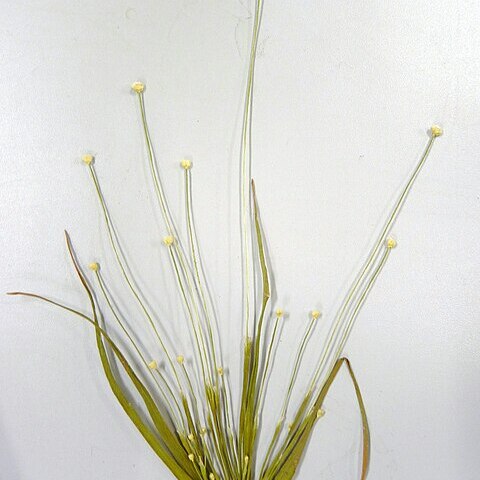Herb 2.5–18 (–23) cm high. Leaves filiform to linear, 2–9 cm long, 0.16–2 mm wide, 3-or 4-nerved. Peduncle 2.5–16 cm long (rarely to 23 cm). Sheath 6–25 mm long. Flower heads ovoid to hemispherical, 1–3.5 (–4.5) mm long, 1.5–4.5 (–6) mm wide. Involucral bracts hyaline, obovate to narrowly elliptic, 0.8–2.25 mm long, 0.3–1 mm wide, obtuse, glabrous, not reflexed at maturity. Floral bracts hyaline or black, elliptic to narrowly lanceolate, 0.9–2.25 mm long, 0.225–0.6 mm wide, acute, glabrous. Receptacle sparsely hairy. Male flowers: sepals 3, fused but split on one side to form a spathe which is often shallowly to deeply 3-lobed, black, 0.65–1.6 mm long, 0.23–0.5 mm wide, acute to obtuse, glabrous or with white or hyaline hairs in apical fringe; petals 3, hyaline, equal, triangular, acute, pubescent with apical fringe of white hairs; stamens 6; anthers yellow. Female flowers: sepals 2 or 3, hyaline or black, equal or sometimes one slightly different in size, linear, lacking dorsal keel or wing, 0.5–1.4 mm long, c. 0.03 mm wide, acuminate, pubescent with marginal hyaline hairs or glabrous; petals absent; ovary 3-locular. Seeds 0.22–0.43 mm long, 0.15–0.3 mm wide, smooth, lacking sculpturing or epidermal cell outline only faintly visible.
Small tufted annual.. Leaves narrowly linear to acicular, setaceous-tipped, forming a neat dense cluster, 1–3 cm. long, 0.2–2 mm. wide, fenestrate.. Scapes slender, straight, often numerous, 4–13 cm. high, 5-ribbed; sheaths ± equalling the leaves, subinflated, the mouth scarious, shortly obliquely slit.. Capitulum globose to ovoid, 2–4 mm. diameter, grey-and straw-coloured or becoming darker, the bracts very loosely erect; involucral bracts as long as the capitulum, obovate-oblong, rounded becoming lacerate, ascending, pallid, scarious becoming tougher downwards; floral bracts lanceolate-oblong, thinly scarious, pale with a dark central band or sometimes blackish, glabrous or a few inner lightly keeled with fine sparse hairs on the keel; receptacle thinly pilose; flowers trimerous, pedicellate.. Male flowers: sepals connate into a spathe with tridentate tip, dark grey, glabrous; petals included within the calyx, tiny; anthers white, 0.1 mm.long.. Female flowers much reduced and consisting mostly of the gynoecium: sepals 3, 2 or absent, filiform, caducous; petals absent, their position indicated by a node on the ovary stipe.. Seeds 0.3 mm. long, light brown, glossy, faintly reticulate.
Leaves narrowly linear, 2--5(--8) cm, 0.8--1(--1.7) mm wide at middle, glabrous, veins 3(--5). Scapes 6--30, 6--9(--19) cm, 4--6-ribbed; sheath 1.5--2(--3.5) cm; receptacle villous, occasionally glabrous; heads light yellow to dark green, subglobose to broadly ovoid, ca. 4 × 3--3.5 mm; involucral bracts pale green-yellow to blackish, obovate to elliptic, 0.9--1.9 × 1--1.4 mm, membranous, glabrous; floral bracts oblong to oblanceolate, glabrous or occasionally abaxially villous. Male flowers: sepals spathelike, 1.3--1.9 mm, glabrous or abaxially hairy toward 3-cleft apex; petals 3, ovate to oblong, anterior one slightly larger than others, shortly hairy at apex, gland black or brown; anthers white to dusky. Female flowers: sepals 2 or 3, blackish, free, linear, sparsely villous abaxially and at margin, posterior one absent or to 1 mm, lateral ones 1--1.7 mm; petals absent; ovary 3-loculed; style 3-cleft. Seeds ovoid, 0.4--0.5 mm; testa hexagonally reticulate, prickles absent. Fl. and fr. Jun--Oct.
Capitula small, about 2·4-3 mm. diam., brownish or fuscescent.
Scapes slender, usually less than 4 in. high
Leaves numerous, setaceous


